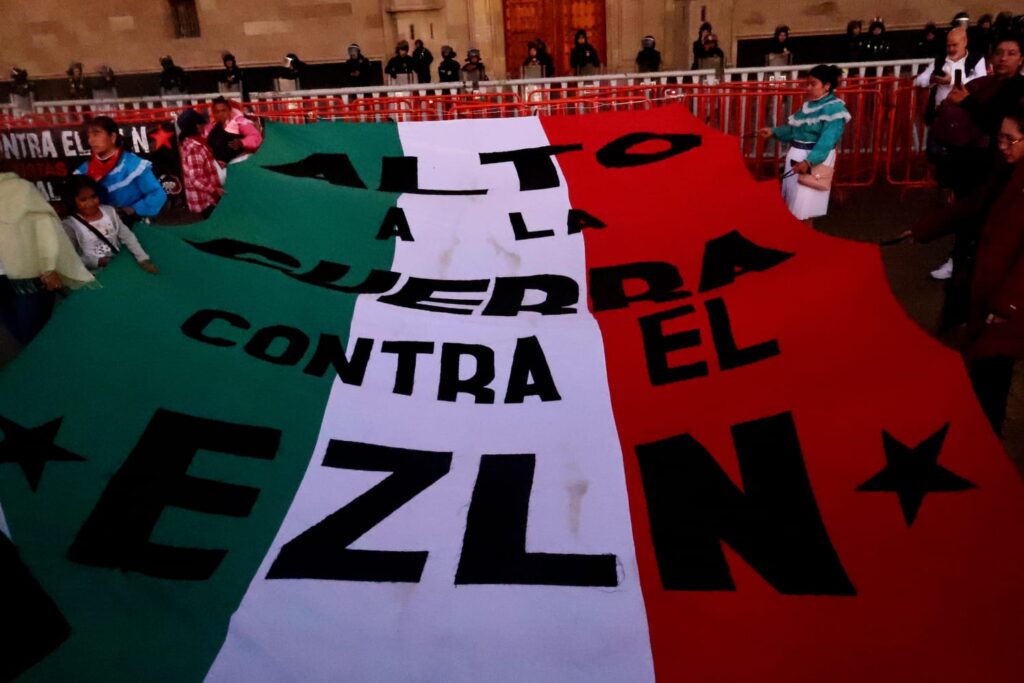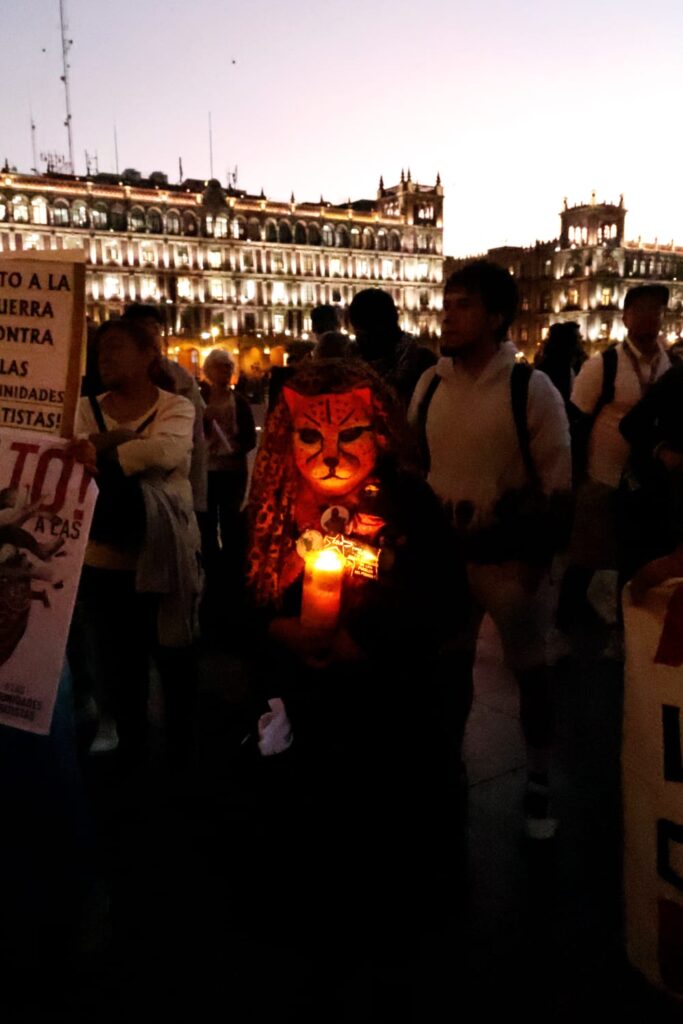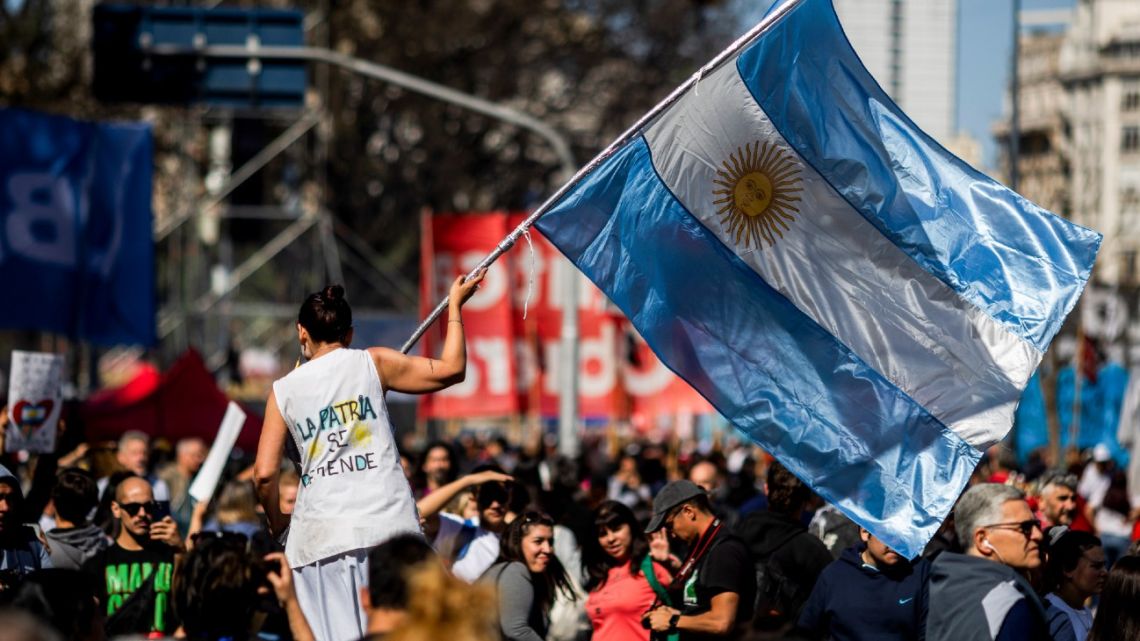Mexico City, Mexico – Indigenous community members and civil society organizations held a rally in Mexico City on October 24 to denounce what they describe as an active war taking place in the southeastern state of Chiapas.
In front of the National Palace, which houses the Executive Branch of government, protesters urged President Claudia Sheinbaum’s administration to do something about rising violence between warring drug cartels and the Mexican military in the region. Much of which has impacted Indigenous communities in Chiapas as well as members of the Zapatista Army of National Liberation (EZLN), a leftist guerilla movement that controls vast swaths of the state, but whose influence has recently been encroached upon by drug cartels and right-wing paramilitary groups.
“It is the same state, the same narco-state that does nothing to stop what is happening in Chiapas and throughout the country. We are witnessing how they are killing people, and the government does nothing—neither the one that left nor the one that is currently in power. They continue to kill those of us who fight; they criminalize us, imprison us, and make us disappear,” Isabel Valencia, a member of the Otomí Indigenous community and a spokesperson for the rally, told Aztec Reports.
The march and ensuing rally last week was called in reaction to an attack against a Zapatista community by armed groups and the October 20 murder of Marcelo Pérez, a priest, human rights defender and member of the Tzotzil Maya Indigenous community in Chiapas.
Violence in Zapatista-held territory
The Zapatistas have held territory in Chiapas since their 1994 armed uprising against the government. Since then there have been periodic clashes between paramilitary groups aligned with the Mexican state to take back control of the territory.
In the past few years, violence has escalated again. In February 2021, the Zapatistas said that Chiapas was on the “verge of a civil war,” as drug cartels (mainly the Sinaloa and Jalisco New Generation cartels) battled over control of the territory, which sits on the border with Guatemala and is valuable for both human and narcotics smuggling.

In the past nine months, over 1,000 people in Chiapas have been forcibly displaced, some even fleeing to Guatemala, according to The Guardian.
Government-aligned paramilitary groups and nearby ranching communities have also threatened the Zapatistas’ existence in some parts of Chiapas. According to the Fray Bartolomé de Las Casas Human Rights Center (Frayba), a rights group closely aligned with the Zapatistas, 46 civilians entered the Zapatista community of “6 de Octubre” (6th of October) carrying firearms and demanded that the Zapatistas leave the territory.
At last week’s rally in Mexico City, Enrique Davalos, an activist, told Aztec Reports accused the government of coercing nearby communities to turn on the Zapatistas after living next to them for years.
“The invasion of the ‘6 de Octubre’ community, where a group of neighbors with whom they had a relationship, well, if you want to say not brotherhood but an acceptable relationship for a long time, are used by the government,” said Davalos. “Get those Zapatistas out and we will give you the territory,” he said the government urges, “in addition to being supported by criminals who arrive with high-powered weapons.”

Another driver of the Mexico City protests was the recent murder of murder of Father Marcelo Pérez in San Cristóbal de Las Casas, a municipality in Chiapas.
The priest was beloved for his work in his community and was vocal about the violence being inflicted upon Chiapas in recent years – rhetoric that lead to death threats and Mexico’s National Commission for Human Rights (CNDH) instructing the government to provide him with a security detail in 2015, according to Frayba.
In September, Pérez led a march to the state capital to demand peace. A month later, he would be shot in the head while leaving mass in San Cristóbal de las Casas.
Commercial development in Chiapas
In addition to its value as a smuggling route from Central America, in recent years, Chiapas has become increasingly important for commercial development and mega-projects funded by the Mexican government.
One of former President Andrés Manuel López Obrador’s signature infrastructure projects is Tren Maya (Maya Train), which traversers the Yucatan peninsula and connects popular tourist destinations like Cancun to Mayan communities more inland Campeche, Tabasco and Chiapas. The government had also courted foreign investment to develop the region, with the American Chamber of Commerce in Mexico announcing this year investments from companies like Visa, Uber, Meta, Kenworth, FedEx, Mercado Libre, Metlife, Organon, Rockwell Automation, AECOM and American Tower.
“Megaprojects are arriving in Zapatista territories, such as the Maya Train and the Interoceanic Corridor, among many others, trying to pass through Zapatista land. This is a way for them to protect the interests of capitalism because we see that those soldiers, that police, that the narco-state is destroying the territories; they do not protect the people, they protect their interests,” said Valencia, the member of the Otomí Indigenous community.

The Zapatistas have opposed the Maya Train from the get-go. According to the Zapatistas, the railway threatens their communities, the environment, and their way of living.
“Five hundred and twenty-eight years and the bad governments impose a counterinsurgency war and the militarization of our Indigenous peoples and communities, as a guarantee for the ‘development’ of megaprojects such as the Maya Train,” wrote the Zapatistas in October 2020, the year construction on the railway began.
For the protesters, the Zapatista’s and Indigenous groups’ resistance to regional mega development projects has put a target on their back.
“This is what they call outsourcing,” said Davalos, who accused the Mexican military of using criminal groups to repress dissent in Chiapas. “It’s astonishing the military power that the [Army], the Navy, and the National Guard have. I don’t know if they think we’re stupid enough to believe that an army with that much power cannot dismantle and destroy these drug trafficking groups, no matter how powerful they are. But they don’t want to do it; rather, they use them.”

 By Latin America Reports | Created at 2024-10-31 00:03:10 | Updated at 2024-10-31 15:34:00
1 day ago
By Latin America Reports | Created at 2024-10-31 00:03:10 | Updated at 2024-10-31 15:34:00
1 day ago



